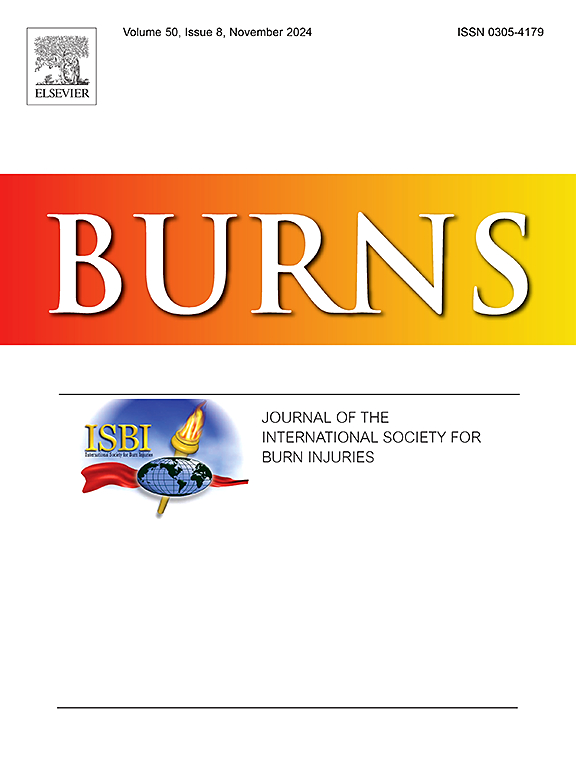大范围烧伤≥ 70 % TBSA患者心脏生物标志物与死亡风险关系的回顾性研究
IF 2.9
3区 医学
Q2 CRITICAL CARE MEDICINE
引用次数: 0
摘要
背景:大面积烧伤患者面临显著的死亡风险,其病情往往与严重的心功能不全密切相关。然而,心脏生物标志物与烧伤患者死亡率之间的相关性(≥ 70 %的总体表面积(TBSA))仍未得到充分探讨。材料与方法研究对象为昆山工厂爆炸事故159例患者。采用联合模型评估纵向数据与生存结果之间的关系。此外,随机森林被用来建立新的临床阈值,并揭示了在已故患者纵向测量所呈现的特定模式。构建相应的生存曲线并计算预测能力。最后,采用多变量Cox回归分析来确定这些新的阈值是否能独立预测总生存期(OS),随后采用144例TBSA≥ 70 %的10年队列进行外部验证。结果在所有心肌指标中,BNP水平与死亡率的相关性最显著(HR:6.831, 95 %CI: 6.122-7.539)。同样,proBNP、CK-MB、IL-6、Mb、d -二聚体和cTnI呈正相关。TBSA也与预后有显著关系。新阈值定义的具体规则可以有效区分高危和低危患者。烧伤后56天内连续两次或两次以上BNP测量值大于或等于519.91 pg/ml的患者死亡风险较高(间隔平均值[SD], 1.06[0.77]天)。基于BNP新临界值建立的预测条件是OS的独立危险因素。外部验证证实了模型的良好性能。结论大范围烧伤≥ 70 % TBSA患者的心脏生物标志物,尤其是BNP与死亡显著相关。这揭示了心脏应激与烧伤后死亡率之间的潜在相关性。本文章由计算机程序翻译,如有差异,请以英文原文为准。
Exploring the relationship between cardiac biomarkers and mortality risk in extensive burned patients ≥ 70 % TBSA: A retrospective study
Background
Extensively burned patients face a significant risk of mortality, with their condition often being closely associated with severe cardiac insufficiency. However, the correlation between cardiac biomarkers and mortality in patients with burns involving ≥ 70 % total body surface area (TBSA) remains underexplored.
Materials and methods
The study included 159 patients from the Kunshan factory explosion. A joint model was applied to assess the relationship between longitudinal data and survival outcomes. In addition, random forests were utilized to establish new clinical thresholds and to uncover the specific patterns presented by longitudinal measurements in deceased patients. We constructed the corresponding survival curves and calculated the predictive power. Finally, multivariate Cox regression analysis was used to determine whether these new thresholds independently predicted overall survival (OS), which was followed by external validation employing a 10-year cohort of 144 burn patients with TBSA ≥ 70 %.
Results
Of all the myocardial markers, BNP levels presented the most statistically significant association with mortality (HR:6.831, 95 %CI: 6.122–7.539). Similarly, proBNP, CK-MB, IL-6, Mb, D-dimer and cTnI displayed positive correlations. TBSA also showed a significant relation to outcomes. The specific rules defined by the new thresholds could effectively distinguish between high-risk and low-risk patients. Patients with two or more consecutive BNP measurements greater than or equal to 519.91 pg/ml within 56 days after burns had a higher risk of death (interval mean [SD], 1.06 [0.77] days). The predictive condition established on the basis of this new cut-off value of BNP was an independent risk factor for OS. External validation confirmed the model’s satisfactory performance.
Conclusion
Cardiac biomarkers, particularly BNP, were significantly associated with death in extensively burned patients ≥ 70 % TBSA. This revealed a potential correlation between cardiac stress and mortality after burn injury.
求助全文
通过发布文献求助,成功后即可免费获取论文全文。
去求助
来源期刊

Burns
医学-皮肤病学
CiteScore
4.50
自引率
18.50%
发文量
304
审稿时长
72 days
期刊介绍:
Burns aims to foster the exchange of information among all engaged in preventing and treating the effects of burns. The journal focuses on clinical, scientific and social aspects of these injuries and covers the prevention of the injury, the epidemiology of such injuries and all aspects of treatment including development of new techniques and technologies and verification of existing ones. Regular features include clinical and scientific papers, state of the art reviews and descriptions of burn-care in practice.
Topics covered by Burns include: the effects of smoke on man and animals, their tissues and cells; the responses to and treatment of patients and animals with chemical injuries to the skin; the biological and clinical effects of cold injuries; surgical techniques which are, or may be relevant to the treatment of burned patients during the acute or reconstructive phase following injury; well controlled laboratory studies of the effectiveness of anti-microbial agents on infection and new materials on scarring and healing; inflammatory responses to injury, effectiveness of related agents and other compounds used to modify the physiological and cellular responses to the injury; experimental studies of burns and the outcome of burn wound healing; regenerative medicine concerning the skin.
 求助内容:
求助内容: 应助结果提醒方式:
应助结果提醒方式:


